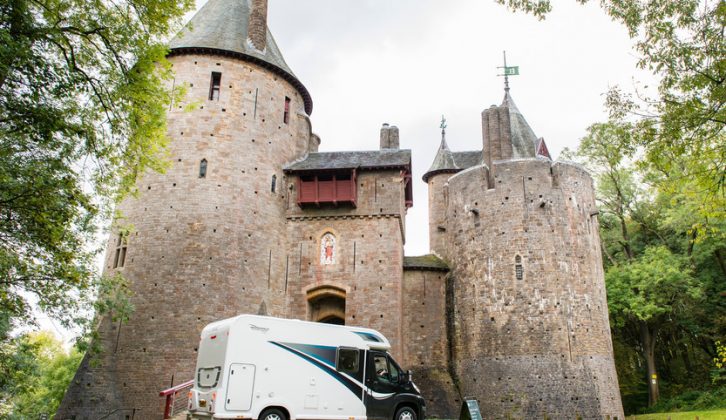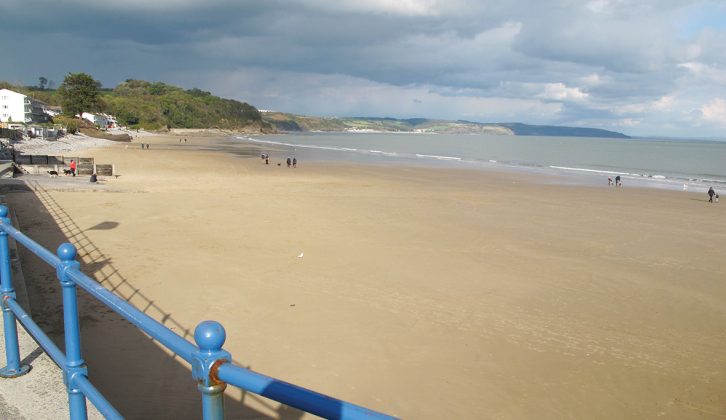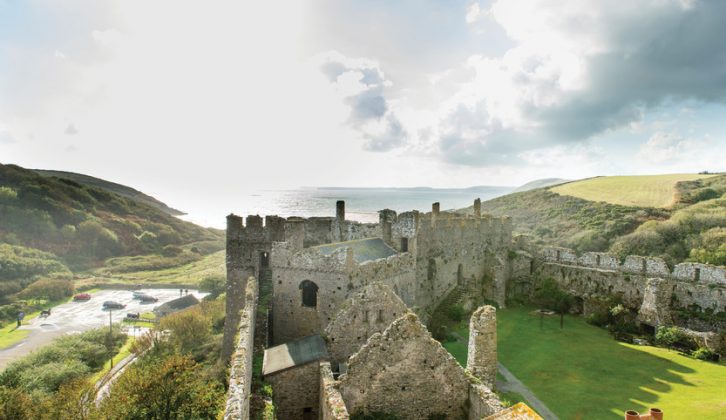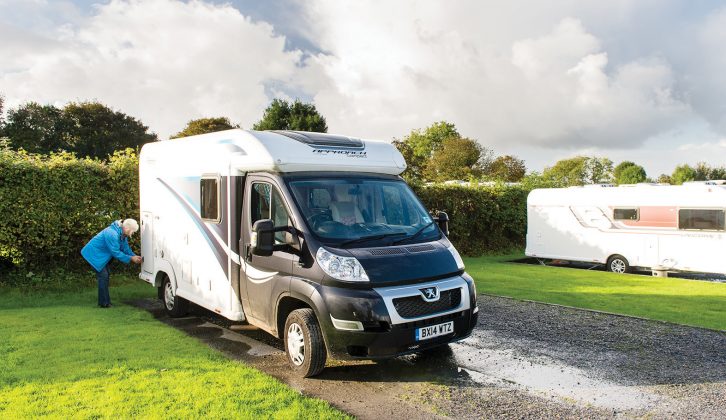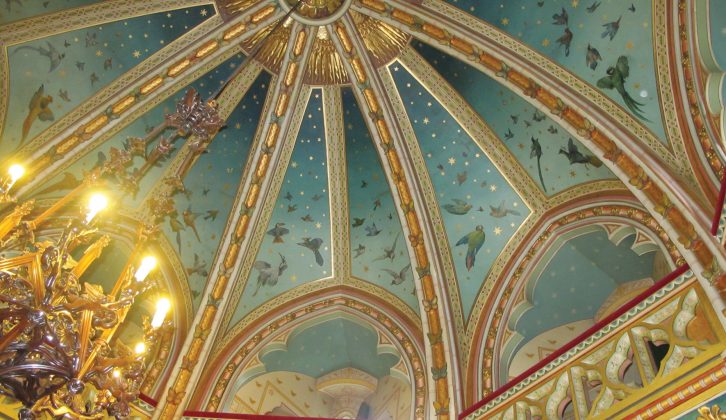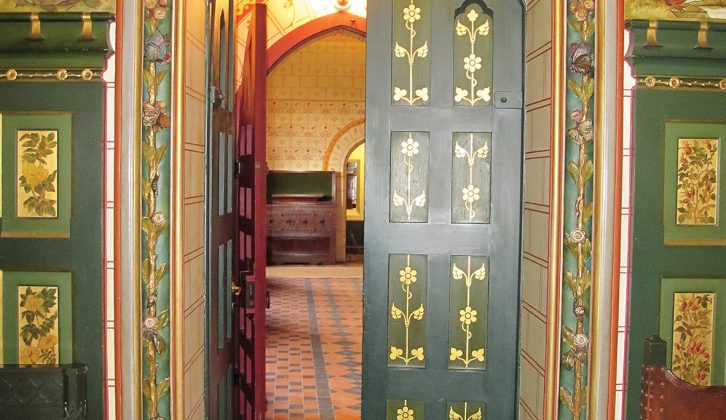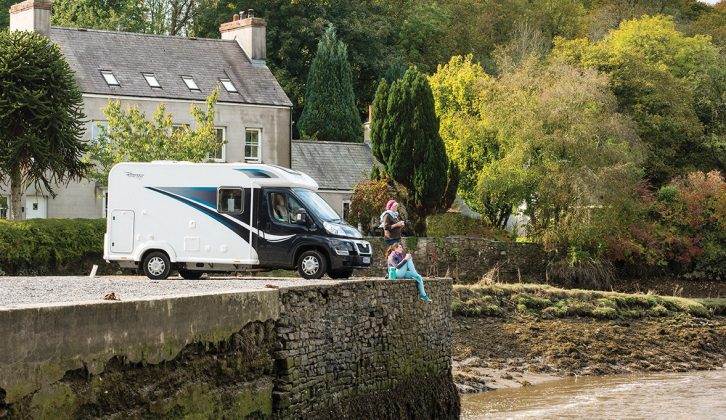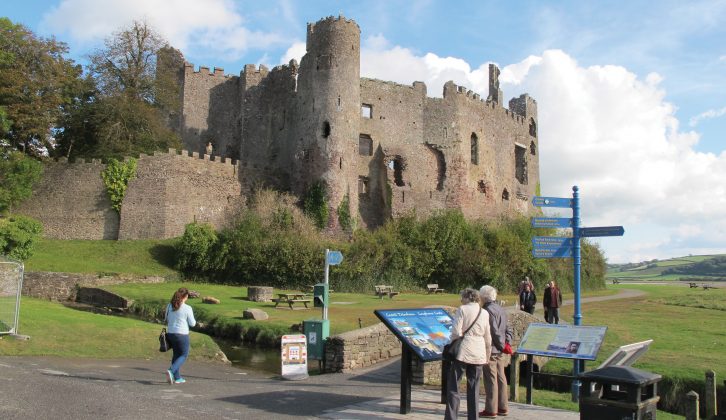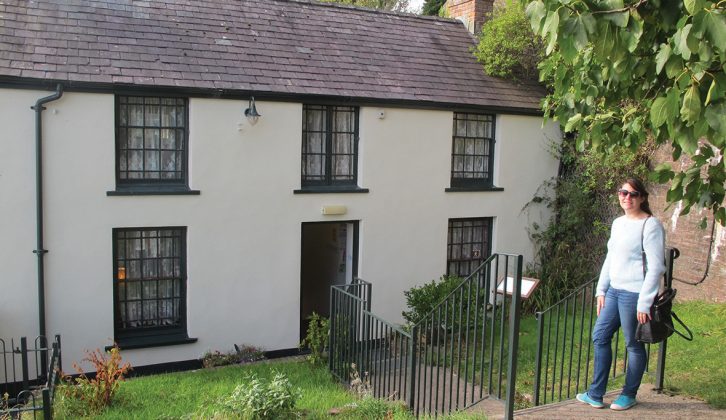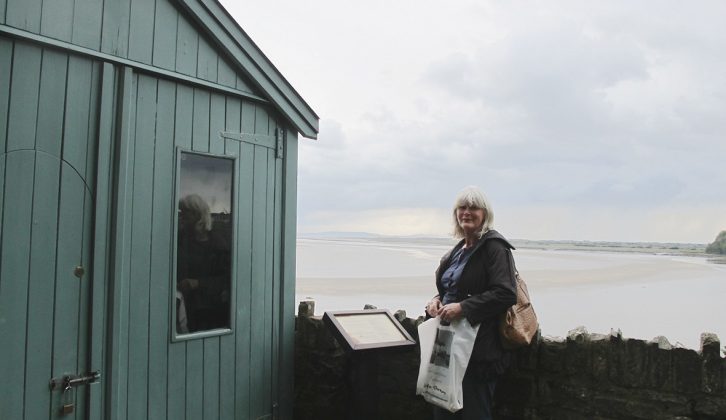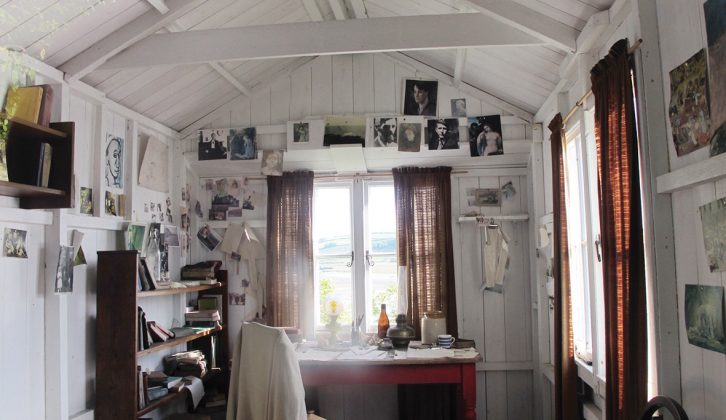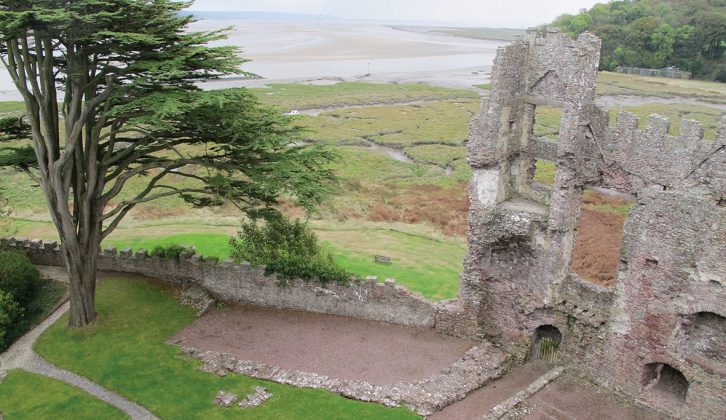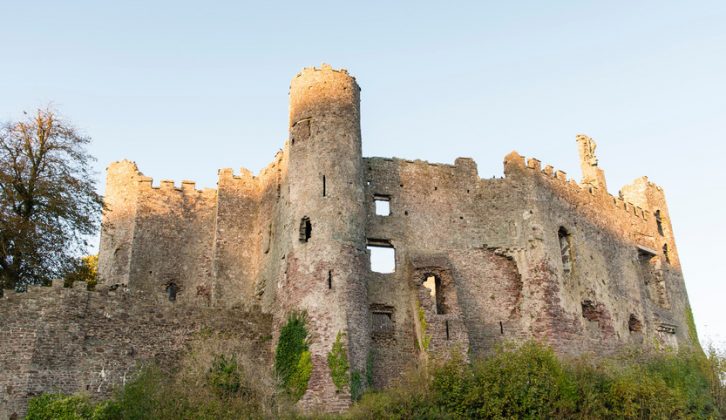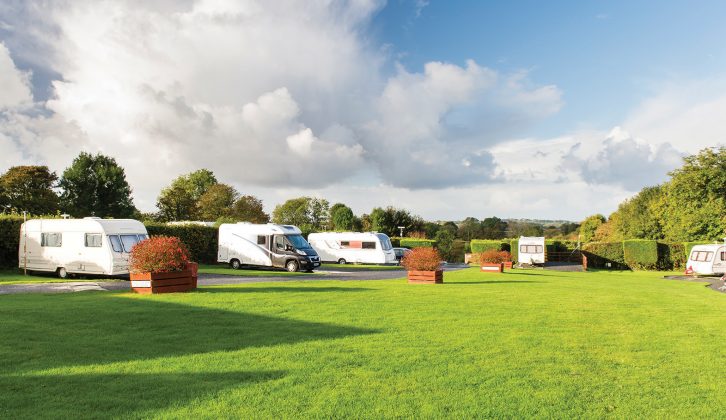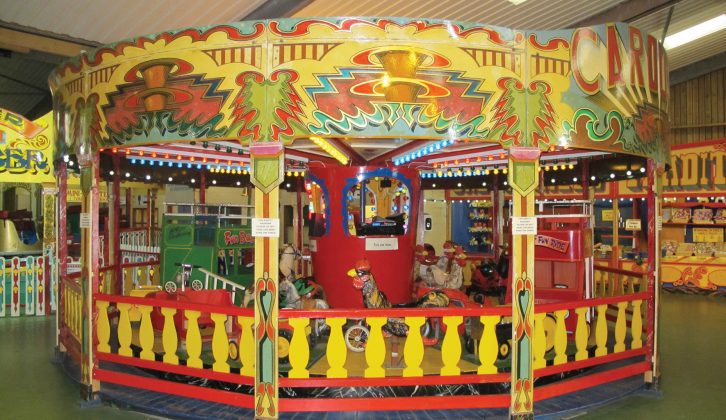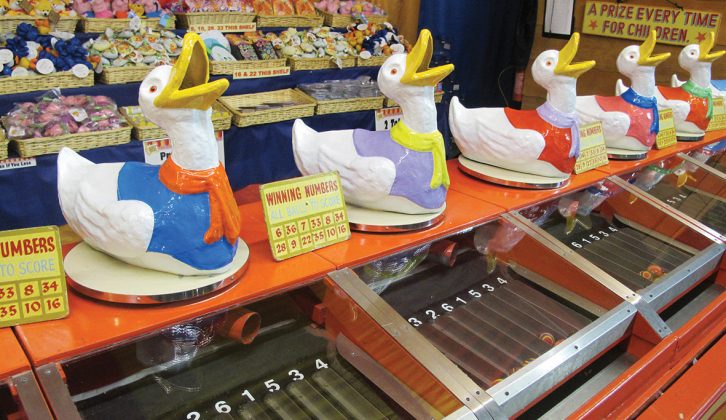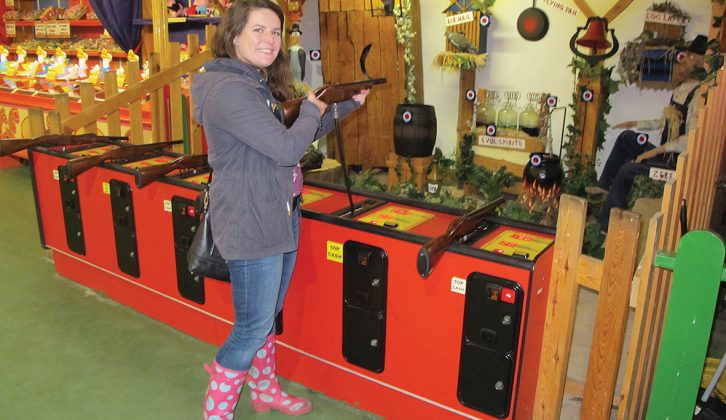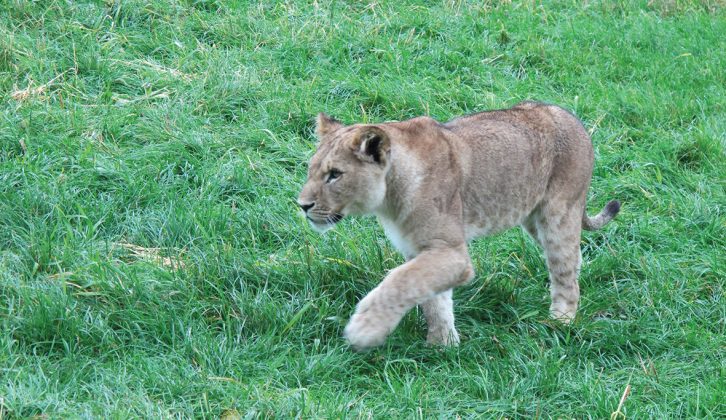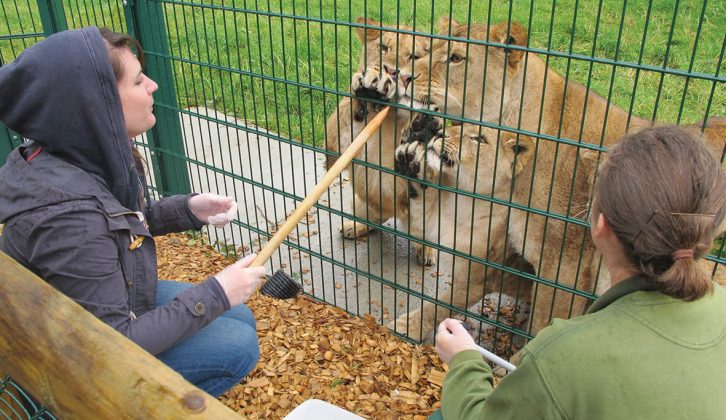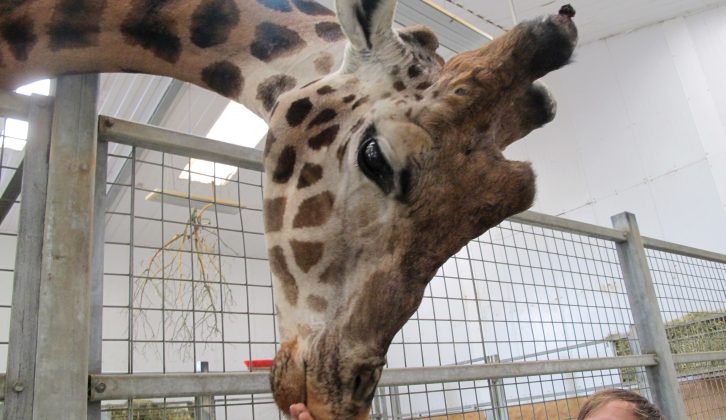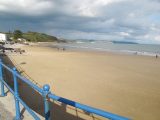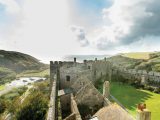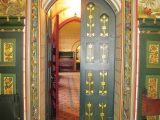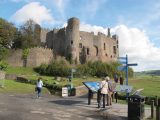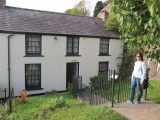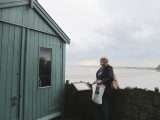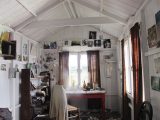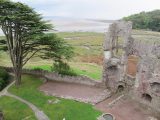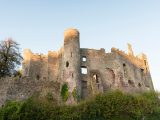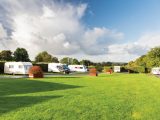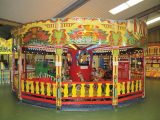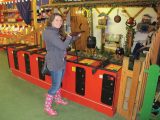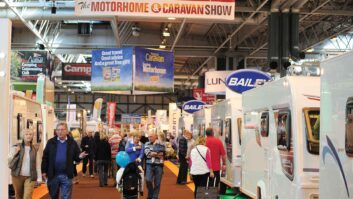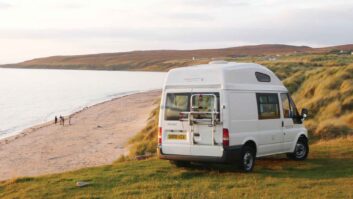Bryony looked at me curiously; “I can hear the mud,” she said. I stopped to listen, but she was right. There was a sucking, slurping noise as the River Taf began its swift retreat from the paths, mudflats and car park that flanked Laugharne Castle, back into the estuary.
We were in South Wales to visit a small handful of the 400-plus castles that the country boasts. Wales does have more than its fair share; the tourist body Visit Wales calls it the ‘castle capital of Europe’ and with more castles per square mile than anywhere else in the world, it’s quite a modest claim. Choosing an area to focus on was hard but we settled on a gentle meander along Wales’s south coast that would take just a few days.
Laugharne is reasonably easy to access. From the A40 you join the undulating A4066; take extra care as you come into the village. The road is narrow but drivers are considerate around these parts and you can usually wiggle around each other. You pass the castle entrance before you reach the car park, which has plenty of room for motorhomes, although wild camping may not be advisable because estuary water could easily be sloshing around your tyres. There is a notice warning of the times of high tides and we marvelled at the cavalier attitude of dog walkers to these – they were clearly accustomed to the extremes and had the times committed to memory.
The ‘mud’ remark came while Bryony and I were following the path below the walls of the ruined castle to Dylan Thomas’s Writing Shed. There are plenty of places to stop and stare and picnic – tide permitting – and you’ll want to because the view is gorgeous; it’s all big horizons across mudflats and glittering water towards distant hills. And in a shelter along the path you can read passages from Thomas’s famous 1954 radio play Under Milk Wood.
“You can hear the dew falling, and the hushed town breathing.”
There was no mention of hearing the mud unless that is what he meant by “you alone can hear the darkest-before-dawn, minutely dewgrazed stir of the black, dab-filled sea.”
We climbed the steps to the author’s Writing Shed overlooking the estuary; what a view he had, lucky man. It was breathtaking! Did it inspire, I wonder? Many writers have drawn stories from the places they loved best, and we’ve put together our top 10 UK literature tours in a separate blog.
We walked on to the Boathouse, where Thomas lived for the last four years of his life with his wife Caitlin and children. It’s a modest dwelling where you can catch up on Thomas’s life and times, view his washing in the garden, have a cuppa in the café and buy a Thomas tome from the small shop: I settled for A Portrait of the Artist as a Young Dog, which was first published in 1940.
Norman Marcher lords built castles
From the Writing Shed, we took the upper road to Laugharne Castle’s entrance. The original castle was one of a cluster that defended the waterways leading into the heart of South Wales. They were built by Marcher lords – the Norman nobles who were supported by 12th-century monarch King Henry II of England, who was also Duke of Normandy.
The remains of the castle date from the late 13th century, when it was owned by the de Brian family, who remained lords of Laugharne until the late 14th century. There followed a period of decline until Elizabeth I gave the castle to Sir John Perrot, whose main residence was nearby Carew Castle; he converted it into a Tudor manor. It was attacked during the Civil War and gradually fell into decay. In the 18th century, it was admired as a romantic ruin and in the 19th century it gained a formal garden.
Hot-desking in the shed
It drizzled as we wandered the ruins, which are undergoing slow renovation, and climbed the tower for a view over the estuary, made grey by the rain. We found the summerhouse that was used as a writer’s retreat by both Dylan Thomas and author Richard Hughes, and were charmed by the terse little note from ‘your loving wife Caitlin’ to Dylan, admonishing him for leaving Richard’s radio on and running down the battery.
We dashed through the rain to Brown’s Hotel, Thomas’s favourite watering hole, for coffee and hot chocolate. I imagined the atmosphere of the place during Thomas’s time, the air thick with smoke and banter. As a daytime venue, it was a bit sterile, but I’m sure that changes come the evening.
Giraffes in Pembrokeshire
Our campsite for the duration of our trip was Stone Pitt Holiday Park in Kilgetty, Pembrokeshire. It made a good base for everywhere we wanted to visit and its owner, Claire Morris, was extremely helpful, despite being exceedingly busy. She was taking seasonal caravans in and out of storage as their owners came and went. Claire came to check that we were settled in.
“You can sometimes see the giraffes from here,” she said.
“Giraffes?”
It turns out that the only giraffes in Wales are housed less than a mile up the road at Folly Farm Adventure Park and Zoo. We knew where we were heading the next day – I love giraffes – but in the meantime settled on dinner at the local Chinese restaurant, the Dragon Palace, recommended by Claire.
It’s good to know people in the know. Claire had rung ahead and organised a guide to take us around the zoo. We parked up easily and went to meet him. Folly Farm makes a wonderful family day out come rain or shine. Our first stop was noisy and I wished I’d brought earplugs. A vast hangar houses a clamorous arrangement of vintage fairground rides and sideshows that includes carousels, a cakewalk (apparently based on African-American dance competitions in which the winners of the most intricate dance were awarded a cake), dodgems and chair-o-planes. Most of the rides were sourced in the UK, and they are magnificent to look at, but not to listen to. I escaped the cacophony while Bryony had a go on the shooting range.
Our next stop was a quieter affair – the petting zoo, where Bryony and I were persuaded to milk goats. In for a penny… The goats were patient, our instructors tried their best, and I managed a squirt or two, but neither of us will be making career switches to dairymaid. Moving swiftly on, we passed chicks, guinea pigs and ponies, out of the barn and to, for me, the main event – the giraffes. What magnificent creatures, and so TALL: their torsos start way above my head.
There are four giraffes at Folly Farm and two scattered – legs and necks went in all directions – as we entered the covered enclosure with offending umbrellas; they are clearly nervous beasts. They calmed down when a bucket of delicious white cabbage – looking awfully like the previous night’s prawn crackers – was proffered. Their huge tapering heads with slipper-like lips swayed on long necks as they took the cabbage gently from the keeper’s hand. Then I had a go and stroked the nose and fed a giraffe – wonderful!
The four at Folly Farm are all male and good friends because there are no females to get hot under the spots about. Apparently, it wasn’t discovered until quite recently that there are nine species of giraffe, so our four boys, who were all born in zoos, will never be part of a breeding programme because they are hybrids. At 19 feet, Zulu is the tallest of the quartet and the tallest giraffe in the UK, and can just get under the entrance of the indoor enclosure without ducking.
Feeding the lions
I could have dallied there for hours but we were off to meet Folly Farm’s most recent addition, a pride of lions. Hugo and Lunar are the imposing-looking parents of four large cubs and Bryony was going to feed them. Their enclosure cost a cool £0.5m and comprises two acres of fenced-off grassland and a glass viewing area. I was watching Lunar the lioness alongside another visitor when the lion suddenly licked the glass right in front of the visitor’s face – a friendly gesture or was she hungry?
To feed the lions Bryony wore rubber gloves, the keeper put chunks of meat onto a stick for Bryony to poke through the railings and there was a lot of enthusiastic jumping up on the other side to be first at the meat. Bryony was thrilled: I wonder how tempted she was to put her hand through to stroke a lion cub.
It was off to Penguin Coast next. We watched a small huddle of penguin rookies taking tentative steps before going to watch the show-off adults putting on their underwater displays. These perennial crowd-pleasers never fail to put a smile on my face. We had already spent hours here and my tummy told me it was way past lunchtime.
From chippy to castle
I had a hankering for fish and chips, and just a 10-minute drive away was the seaside town of Saundersfoot. Parking by the harbour was easy; the huge car park offers 24- and 48-hour parking, but not for motorhomes, which must vacate the car park by 9.30pm.
The harbour is very pretty and has a lovely wide stretch of sandy beach. Four o’clock was late for lunch but we found a sizeable chippy overlooking the water and I was able to indulge my whim. After filling our stomachs we had a short wander around the village, and Bryony bought Welsh cakes, which looked awfully like squidged scones to me.
We hadn’t ventured far but it had been an exciting day and we were both tired. We spent a quiet evening in.
Cresswell Quay and Carew castle
We had come to see castles and – what with giraffes and lions – had only managed one. We had to do better, but first we wanted to look at Creswell Quay, a picturesque spot for an impressive photo, reckoned our hostess Claire. There was a nice pub there, too, the Cresselly Arms. The tide was out when we stopped for a photo. The water in the surrounding creek was so low it felt like being on a marooned ship. We popped across the road to the pub to speak to the landlords. “Come back this evening and the high tide will have the water lapping at the pub door.” The pub has had rave reviews but I didn’t fancy getting my feet wet for an evening snifter.
We drove back towards the A477, passing a car park and picnic area across a tidal millpond from Carew Castle. We stopped to take in the view. It’s a lovely spot and the darkening clouds created the effect of brooding mystery. The stone castle’s history spans more than 1000 years since Gerald de Windsor built a keep. It was on the site of an old manor house, which was part of the dowry of his wife, Nest, a princess of Deheubarth.
It grew from there, until it was gifted to John Perrot (remember, he owned Laugharne Castle), who made the final domestic alterations to the building, turning the fortress into yet another Tudor manor. (How many did he need?)
There’s a mile-long circular walk, which takes in the tidal mill, the stunning 11th-century Celtic cross and the picnic area where we were parked, and is popular with dog walkers. There’s also a legend involving a Barbary ape kept by the castle’s cruel 17th-century lord, Sir Roland Rhys: I will leave you to look it up, but ghosts are said to roam.
Manorbier Castle
We crossed Carew Bridge, which is a scheduled monument, and headed towards Manorbier Castle about seven miles east of Pembroke overlooking Manorbier Bay. There is a small parking area outside the gates, but motorhomes would be better off parking in the spacious car park below the castle and close to the beach. A path from the road leads to the castle; otherwise you must follow a steep road around. It stands high on a red sandstone spur opposite the beautiful Church of St James.
Manorbier Castle was begun in the 12th century and building continued into the 13th century by the Norman baron, Odo de Barri, and his descendants. It is the birthplace of Gerald of Wales, a crusader and prolific writer whose books deliver a vivid depiction of medieval Wales.
We met the current owner, Emily Naper – a descendant of the Philips family who took on the castle in the 17th century – in the very quaint tearooms within the castle walls. She told us that the castle had suffered only two minor attacks – one by a de Barri reclaiming what was his, and one under Oliver Cromwell which was why it was in such good condition.
We were blessed with a sunny day for our visit and enjoyed the castle gardens designed by Irish gardener Daphne Shackleton. Emily joined us while we roamed the buildings and showed us a stunning view of the sea from the Watergate. She told us that it was at Manorbier that the 23-year-old Virginia Woolf decided to become a writer.
The castle holds musical and theatrical events during the summer and regularly hosts weddings so if you are thinking of visiting on a Saturday do check Manorbier Castle’s website to make sure it is open. There are two touring parks around Manorbier and, if you are meeting up with non-touring friends, they can stay in the Victorian house within the castle walls.
Pub food on the beach
We took the ’van along the road a short way for superb views over Manorbier Bay before turning around and making the half-hour journey to Wiseman’s Bridge, another Claire recommendation, for an early evening supper. This was a great pub serving good food that is right on the beach, alongside which there are plenty of places to park. Apparently, the beach had been used for rehearsals of the D-Day landings. There was a campsite opposite where we could have stayed had we wanted to make an evening of it, but we were just 10 minutes’ drive from our base at Kilgetty and headed back.
Just off the M4 taking the A470 turn-off towards Tongwynlais, was another castle that had piqued my interest. Many moons ago, I had visited Mount Stuart on the Isle of Bute, the Scottish seat of the Marquesses of Bute, and had been stunned by the splendour of the Gothic interiors. In 1776, through marriage, the Marquesses of Bute – the Crichton-Stuarts – became owners of Cardiff Castle and the smaller Castell Coch. Time was too short to visit the grander Cardiff Castle but I had read that Castell Coch was a Victorian fantasy and, if it was anything like Mount Stuart, I was keen to see it. It did not disappoint.
Flights of fancy at Castell Coch
The approach is through a gate and up a steep hill, with a car park on the left where we left the ’van. The castle is neat, with round turrets and pointy roofs around a small courtyard – above which galleries connect the turrets. You could imagine a Shakespearean play taking place in the courtyard with the audience in the galleries. The rooms had high arched windows and highly decorated walls – some tiled, some painted – and ceilings; I particularly loved the domed ceiling hand-painted with birds, it was gorgeous. William Burges was commissioned by the 3rd Marquess of Bute to create this opulent country retreat in the latter half of the 19th century and he certainly succeeded.
It was an exotic end to our too-brief tour of Welsh castles. As we rejoined the M4 and headed for home I was already choosing a different area of this castle- rich country to explore.
Our campsites for the South Wales castle tour
So, where did we stay during our tour of castles of South Wales? Here’s our short selection.
- Stone Pitt Holiday Park, Begelly, Kilgetty, Pembrokeshire SA68 0XE. 01834 811 086. It’s open all year and there are 36 hardstanding pitches, costing £19-£20 per night for a pitch, hook-up and two people. Stone Pitt is conveniently located on the A478, the same road as Folly Farm Adventure Park and Zoo, and is reasonably easy to access up a slight slope. It’s well placed for accessing the Pembrokeshire and Carmarthenshire coastlines. Amenities are good, with two family shower rooms and facilities for the disabled, as well as a general washblock. Wi-Fi is available throughout the site. There is tourist information but no shop. However, the village of Kilgetty, which is a short drive away, is home to a Co-op supermarket, a post office and a railway station, where trains run every two hours between Pembroke and Carmarthen. We tried the Chinese restaurant – a five-minute drive away from Stone Pitt Holiday Park, with car park – and the Manian Lodge restaurant across the road; both were fine but not remarkable.
- Park Farm Holiday Park, Manorbier, Tenby, Pembrokeshire SA70 7SU. 01834 871 273. It’s open 27 March-31 October and has 63 pitches with hook-up, 20 of which are hardstandings. For your pitch with electric hook-up for two people it costs £19-£23.50 per night. This 25-acre wooded site in Pembrokeshire National Park has all the usual facilities and is half a mile from the beach at Manorbier.
- Wiseman’s Bridge Inn and Caravan Park, Wiseman’s Bridge, Saundersfoot, Pembrokeshire SA69 9AU. 01834 813 236 between 9am and 5pm Mon to Sat and 9am to 3pm Sunday. This campsite is open 1 March-mid-January 2016 and has 16 pitches, all with hook-up. For your motorhome pitch with hook-up for two people it costs £20-£30 per night. The facilities are a little tired but the inn across the road does great food and the beach is open to dogs all year round.
- Antshill Caravan Park, Laugharne, Carmarthenshire SA33 4QN. 07977 110 095. It’s open 1 March-31 October, has 60 pitches, five of which are hardstanding and costs £15-£25 per night for a motorhome pitch with electric hook-up, for two people. The site is within walking distance of Laugharne. It has a new washblock with facilities for the disabled, a clubhouse and a swimming pool. Pitches are a good size.
- Milton Bridge Caravan Park, Milton, Tenby, Pembrokeshire SA70 8PH. 01646 651 204. It’s open 1 March-31 October, then again 20 December-5 January. There are 12 pitches with hook-up, grey-water drainage and hardstanding and it costs £15-£20 per night for a pitch and electric hook-up, for two people. There’s a heated washblock, laundrette and free Wi-Fi. It overlooks a tidal river. Carew Castle is an easy walk from the site, as is an attractive pub with beer garden.
- Cardiff Caravan and Camping Park, Pontcanna Fields, Cardiff CF11 9XR. 029 2039 8362. It’s open all year and has 43 pitches, each with an electric hook-up/fresh water point. It costs £30-£40 per night for your pitch with hook-up, for two people. Just 0.6 miles from the city centre, this site has two washblocks, cycle hire and free Wi-Fi, and is in close proximity to shops, bars and restaurants.
Their huge tapering heads with slipper-like lips swayed on long necks as they took the cabbage gently from the keeper’s hand
